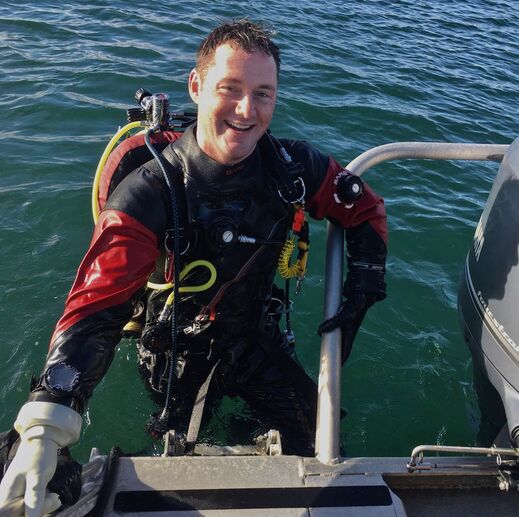|
Bill Halliday
Associate Conservation Scientist, Wildlife Conservation Society Canada I work with Wildlife Conservation Society Canada to study underwater acoustics of marine mammals in the western Canadian Arctic, and examine the impacts of climate change on the acoustic environment for these mammals. The main species that I study are bowhead whales (Balaena mysticetus), beluga whales (Delphinapterus leucas), bearded seals (Erignathus barbatus), and ringed seals (Pusa hispida). The two main impacts of climate change are the direct loss of sea ice, which generally makes the environment louder, and the indirect effect of increased shipping, which similarly increases noise levels. Visit his website here |
|
Kieran Cox
Liber Ero Fellow SFU I am a Liber Ero and NSERC Fellow at Simon Fraser University working with Dr. Isabelle Côté who collaborates with the Juanes lab on several projects. My postdoctoral research applies a three-tiered approach to integrating bioacoustics into the conservation of BC’s marine ecosystems. The three tiers of this project, species-habitat interactions, spatial planning, and policy, are conducted in collaboration with several academic collaborators and conservation practitioners. Together we aim to identify the ecological implications of anthropogenically modified marine soundscapes and construct an evidence-based framework for mitigating the impacts of this pollutant. I am also a member of the FishSounds project. This cross-disciplinary approach combines expertise in fish ecology, bioacoustics, and data management to consolidate fish acoustic research into a publicly available web portal. Our global inventory of research on fish sound production is searchable by taxa, sound characteristics, or reference. I can be reached through my website. |
|
Will Duguid
Biologist, Pacific Salmon Foundation Will is interested in fine scale spatial and temporal patterns of habitat use by Pacific Salmon in their first year at sea. These patterns determine how juvenile salmon experience bottom up and top down regulators of first year survival; which in turn may be the primary drivers of variable recruitment in a changing ocean. Will's current focus is understanding the interactions and juvenile salmon and Pacific Herring in the Salish Sea and understanding the bottlenecks to survival of Pacific Salmon. |
|
Rodney Rountree
Adjunct Professor, UVIC I have worked with colleagues, fishers, and the public to promote the non-invasive use of passive acoustics to fisheries and ecology questions for over 20 years. In doing so, I have recorded soundscapes in estuaries from Florida to Maine, on the commercial fishing grounds of the Gulf of Maine, in the deep-sea off of New England, and in freshwater habitats from the Amazon, Canyons of Utah, and in rivers, lakes, and ponds throughout New England. Today I’m known as “The Fish Listener” a title I promote to emphasize the act of listening to the natural environment. To date I have published over 80 papers and my work has been chronicled in the New York Times, NPR, Discover Magazine, and on-line. I have maintained a web site on fish ecology, http://www.fishecology.org, since 1998 which is popular among both researchers and the general public. The web page archived data on the food habits of 174 species of fish and squid, based on over 123,000 stomach samples collected by the National Marine Fisheries Service between 1973 and 1990 during annual Bottom Trawl Surveys. The site also includes brief descriptions of some of my work with fish sounds (Soniferous studies), including examples of the sounds of numerous species, as well as hundreds of unknown sounds. |
|
Xavier Mouy
Research Acoustician, NOAA Fisheries Xavier completed his PhD with the Juanes Lab in January 2022 and is now a research acoustician at NOAA's Northeast Fisheries Science Center, MA, USA. Xavier continues to collaborate on acoustical studies with the Juanes Lab. He is interested in developing novel hardware and software tools to monitor marine fauna using passive acoustics. During his PhD thesis, he used simultaneous acoustic and video recordings to associate fish sounds to specific species and behaviors. The instrument he put together allowed to localize fish in three dimensions using their sounds and determine movement, calling rates, and source levels of individual fish. Check out his 3 minute thesis presentation here. Also, visit his website here. |
|
Héloïse Frouin-Mouy
Bio-acoustician, JASCO Applied Sciences I work with JASCO, a Canadian underwater consulting company, to study underwater sounds from marine mammals and anthropogenic activities. Previously, during my PhD and my post-doctoral fellowship, I studied the impact of contaminants on the immune system of several marine mammal species. I have worked for more than 10 years on the acoustic spatial and temporal distribution of marine fauna (mainly pinniped and cetacean species) notably in the Arctic. I am collaborating with several national and international institutions to conduct sound scientific research that helps serve conservation and management. Visit her website here. |






